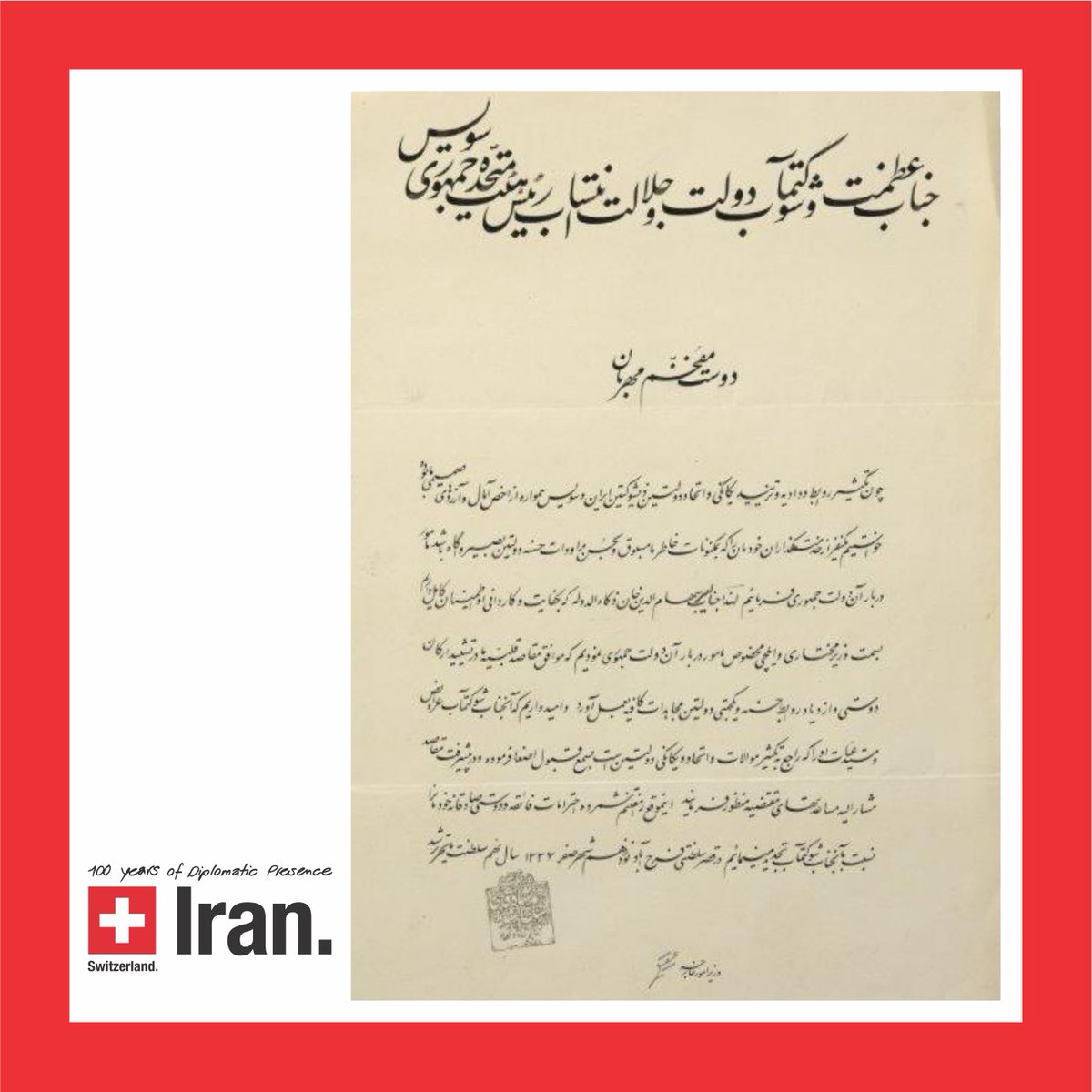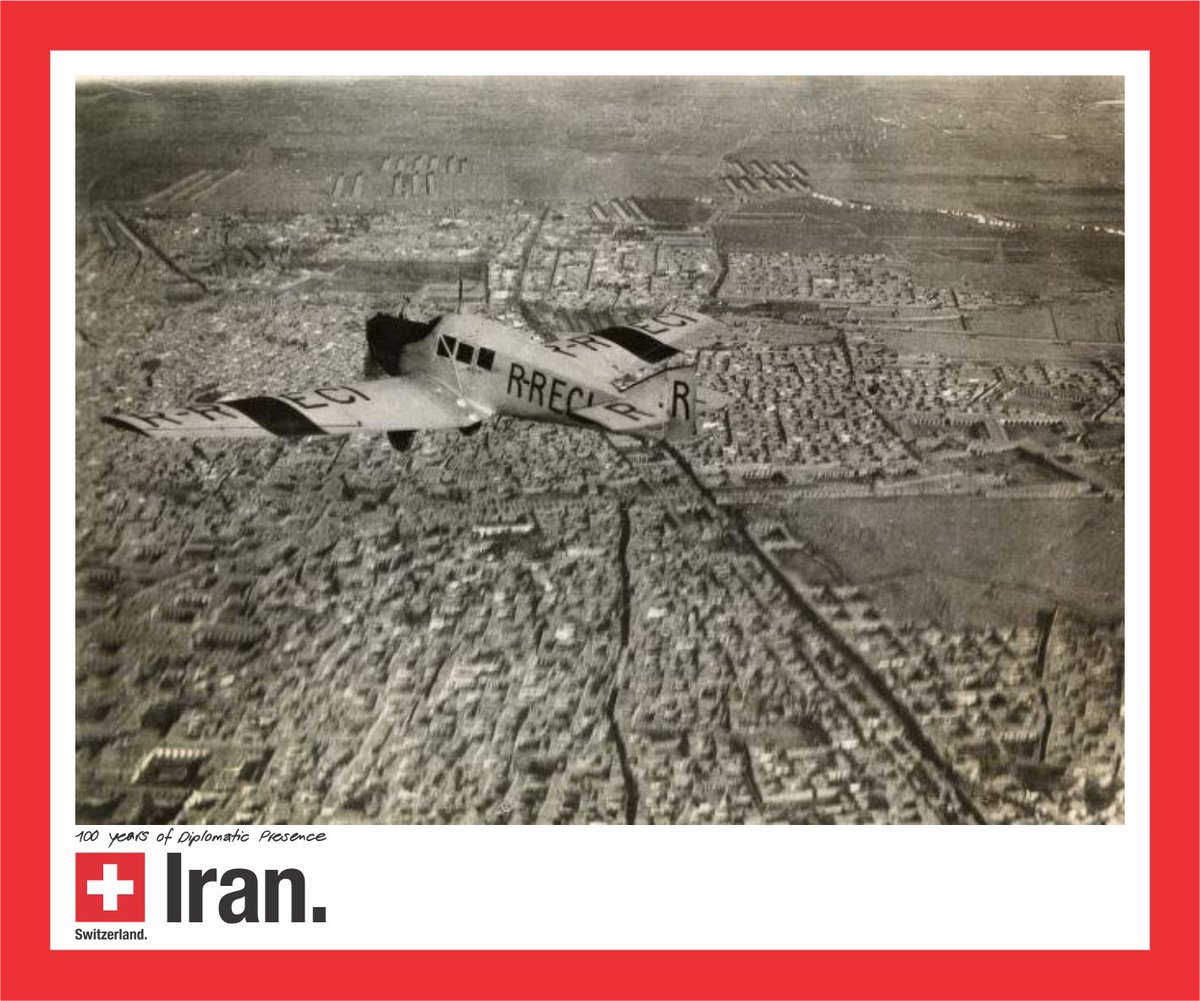The early Swiss presence in Persia was economic. In particular, watchmakers and textile merchants discovered Safavid Iran during the 17th and 18th centuries. The trade relations expanded in the Qajar era, mainly via Beirut, Smyrna and Constantinople – so much so that the Swiss Trade and Customs Minister proposed to the Swiss government to conclude a trade and friendship treaty “in order to make sure that Swiss traders enjoy the same benefits as other most favored nations” (1857).

Swiss trade consisted mainly in exporting textiles, watches, but also musical boxes andenamel to Persia. A treaty of Friendship and Trade – certainly one of the most beautiful documents conserved in the Swiss Federal Archives - was signed during Nasereddin Shah’s five-day visit in Geneva in July 1873. It is said that the crowd welcoming the Shah was so dense that it took his carriage more than an hour to pass 700 meters.
While trade intensified further, relations between Switzerland and Iran soon gained in latitude and depth. In the beginning of the 20th century, growing numbers of Iranians started to pursue their academic studies in Switzerland. One of the most renowned Iranian students in Switzerland was Mohammad Mosaddegh, who studied law at University of Neuchâtel, where, as he felt, he “could study without fearing distraction by other activities or amusements”.
In March 1919, the first Persian Minister (Ambassador) submits its letters of credence to the Swiss Federal Council in Berne. Some months later, on
4th November 1919, the Federal Council decided to establish an Honorary Consulate in Persia, since the small number of Swiss residing in Persia could not justify the opening of a professional representation. The first Honorary Consul of Switzerland, Heinrich Hildebrand, inaugurated the Honorary Consulate on the Swiss National Day – the 1st August 1920.


The attraction Iran presented for many Swiss is particularly evident in photographs of the 1920 and 1930s. The spectacular aerial pictures that the aviation pioneer and photographer Walter Mittelholzer shot in 1924/1925 are of great historical value and were printed in highly popular books. Annemarie Schwarzenbach and Ella
Maillard have inspired generations with their travels to Iran in the 1930s – both have left impressive texts and photographs. The same is true for Nicolas Bouvier, whose opus “L’usage du monde” gives an impressive account of his travels through Iran in the mid-
1950s.

In the 1930s, the Swiss private sector, in particular the Swiss machine industry, watchmakers and chemical industry, pressured the Swiss government to upgrade the Honorary Consulate into a full-fledged Embassy. The Swiss companies noted that competitors had better access to the Iranian market because their respective Embassies could support them. In
1936, the Swiss government sent Armin Daeniker as its first professional diplomat to Tehran.
Another impressive aspect of our common history is the academic and scientific interest for Iran. Fritz Meier, the Swiss Islamic scholar, gained his doctorate at the age of 25, with a thesis on Shaykh Abu Ishaq al-Kazaruni, in
1937. He traveled to Iran the same year
and presented his research on Najm ad-Din Kubra the year after, just to embark on a major work on the Persian poetess Mahsati in 1941. Meier was the first academic to describe the daily activities and spiritual experiences of a mystic. At the age of 34, Meier was appointed maître de conférences for Persian philology at the Farouq University of Alexandria, where he taught Persian in Arabic. His handwritten course is still conserved at the University of Basel, where he continued to teach for 33 more years. His editions of medieval Persian and Arabic texts, his studies of the mystics Abu Said-i Abu l-Khayr and about Mawlana Rumi’s father Baha-i Walad, about sufism, Persian poetry, popular culture, literature and linguistics were groundbreaking in their fields. In 1974,
he was awarded an honorary doctorate by the University of Tehran.
Other Swiss researchers such as Hermann Landolt, Rudolf Gelpke, and a German professor at the University of Bern, J.Chr. Bürgel, contributed to the knowledge and outreach of Persian literature and Persian mysticism. Micheline Centlivres-Demont contributed to the development of the – now famous – Meybod pottery through her doctoral thesis of 1971. Alexandre Moser, a
Swiss architect, helped to plan and supervise the construction of the University of Tehran’s Faculty of Fine Arts in the 1940s, and the Swiss linguist Georges Redard was a pioneer in studying the linguistic diversity of Iran and Afghanistan.
In the 1950s, Swiss geologists invited by Arnold Heim were entrusted by the Iran Oil Company to carry out research and expeditions – and ended up discovering an important oil field in 1956 close to Qom.
During the Second World War, Iran
asked Switzerland to represent its interests in Germany and Italy (1941), mandates that were later extended to the countries occupied by Germany, and that ended with the end of the war. This early mandate underlines that by the
1940s, Switzerland and Iran had developed a trustful relationship, which continues to prevail to this day. Iran has entrusted Switzerland with representing its interests in Egypt (1979), in Saudi Arabia (2017) and in Canada (2019), whereas Switzerland represents the USA and Saudi Arabia in Iran.
In more recent times, the relations of our two countries have continued to deepen. The Swiss President Johann Schneider-Ammann visited Tehran in
2016, while the Iranian President Hassan Rouhani visited Bern in 2018. Both countries have agreed on a road map addressing issues of mutual interest. Over the past 100 years, solid foundations have been built. The Swiss Embassy in Tehran continues to foster the relations between the two countries.
AND IT’S STILL GROWING

.jpg)

.jpg)
|